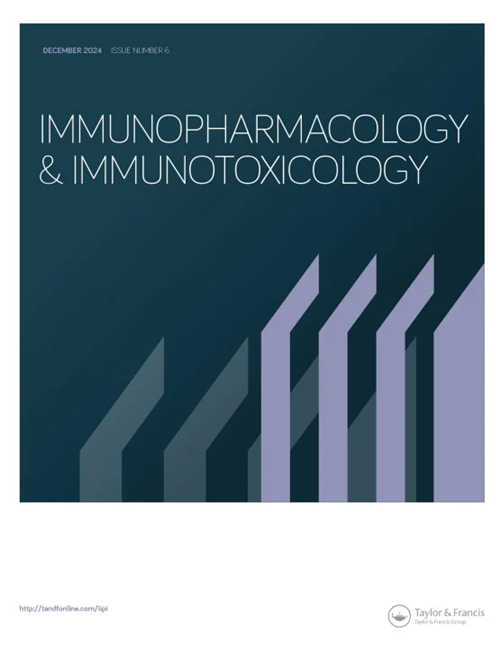Galantamine and wedelolactone combined treatment suppresses LPS-induced NLRP3 inflammasome activation in microglial cells.
IF 2.9
4区 医学
Q3 IMMUNOLOGY
引用次数: 0
Abstract
CONTEXT Inflammasome NLR family pyrin domain-containing 3 (NLRP3) is associated with neurological disorders. Neuroinflammation can be suppressed by inhibiting NLRP3 inflammasome activation, decreasing neurodegenerative disorder progression. We devised a therapeutic technique that can reduce neuroinflammation induced by microglial activation, avoiding neurodegeneration. We aimed to investigate the mechanisms underlying the pharmacological effects of galantamine and wedelolactone by evaluating the response of the nuclear factor kappa B (NF-κB) signaling pathway and NLRP3 inflammasome in lipopolysaccharide (LPS)-activated N9 microglia. METHODS LPS and adenosine triphosphate were used to activate the NLRP3 inflammasome in N9 microglial cells, which were pretreated with galantamine and wedelolactone. Caspase-1, NLRP3, NF-κB, and interleukin (IL)-1β levels were measured using RT-qPCR and immunostaining. RESULTS Combined administration of galantamine and wedelolactone rescued microglial cells from LPS-induced cell death. Furthermore, treatment with galantamine and wedelolactone led to the suppression of NF-κB expression. NLRP3, caspase-1, and IL-1β levels were decreased by the combined treatment. DISCUSSION AND CONCLUSION The concurrent administration of galantamine and wedelolactone effectively suppresses the production of inflammatory cytokines and NLRP3 inflammasome activation in microglia. This inhibitory effect is likely linked to the NF-κB signaling pathway modulation. Therefore, this combined treatment is a potential therapeutic approach for neuroinflammatory diseases.加兰他敏和蟛蜞菊内酯联合治疗可抑制LPS诱导的小胶质细胞NLRP3炎性体活化。
CONTEXTInflammasome NLR family pyrin domain-containing 3 (NLRP3) 与神经系统疾病有关。通过抑制 NLRP3 炎性体的激活可以抑制神经炎症,从而减少神经退行性疾病的进展。我们设计了一种治疗技术,可以减少小胶质细胞活化诱导的神经炎症,避免神经变性。我们旨在通过评估核因子卡巴B(NF-κB)信号通路和NLRP3炎性体在脂多糖(LPS)激活的N9小胶质细胞中的反应,研究加兰他敏和蟛蜞菊内酯的药理作用机制。采用 RT-qPCR 和免疫染色法测定 Caspase-1、NLRP3、NF-κB 和白细胞介素(IL)-1β 的水平。此外,加兰他敏和蟛蜞菊内酯还能抑制 NF-κB 的表达。讨论与结论同时服用加兰他敏和蟛蜞菊内酯能有效抑制小胶质细胞中炎性细胞因子的产生和 NLRP3 炎性体的激活。这种抑制作用可能与 NF-κB 信号通路调节有关。因此,这种联合疗法是治疗神经炎性疾病的一种潜在方法。
本文章由计算机程序翻译,如有差异,请以英文原文为准。
求助全文
约1分钟内获得全文
求助全文
来源期刊
CiteScore
5.40
自引率
0.00%
发文量
133
审稿时长
4-8 weeks
期刊介绍:
The journal Immunopharmacology and Immunotoxicology is devoted to pre-clinical and clinical drug discovery and development targeting the immune system. Research related to the immunoregulatory effects of various compounds, including small-molecule drugs and biologics, on immunocompetent cells and immune responses, as well as the immunotoxicity exerted by xenobiotics and drugs. Only research that describe the mechanisms of specific compounds (not extracts) is of interest to the journal.
The journal will prioritise preclinical and clinical studies on immunotherapy of disorders such as chronic inflammation, allergy, autoimmunity, cancer etc. The effects of small-drugs, vaccines and biologics against central immunological targets as well as cell-based therapy, including dendritic cell therapy, T cell adoptive transfer and stem cell therapy, are topics of particular interest. Publications pointing towards potential new drug targets within the immune system or novel technology for immunopharmacological drug development are also welcome.
With an immunoscience focus on drug development, immunotherapy and toxicology, the journal will cover areas such as infection, allergy, inflammation, tumor immunology, degenerative disorders, immunodeficiencies, neurology, atherosclerosis and more.
Immunopharmacology and Immunotoxicology will accept original manuscripts, brief communications, commentaries, mini-reviews, reviews, clinical trials and clinical cases, on the condition that the results reported are based on original, clinical, or basic research that has not been published elsewhere in any journal in any language (except in abstract form relating to paper communicated to scientific meetings and symposiums).

 求助内容:
求助内容: 应助结果提醒方式:
应助结果提醒方式:


